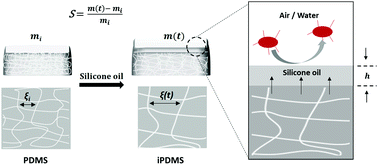Lubrication dynamics of swollen silicones to limit long term fouling and microbial biofilms†
Abstract
Bacterial contamination and biofilm formation on medical devices remain a costly and serious healthcare problem. Silicone (polydimethylsiloxane, PDMS) elastomers are common biomaterials but are susceptible to bacterial surface contamination and biofilm growth. ‘Self-lubricated’ PDMS elastomers (iPDMS) have the potential to greatly reduce rates of cell attachment, biofilm formation and infection. Cross-linked PDMS elastomers immersed in PDMS oil swell to an equilibrium concentration to form a swollen network, and then form a surface liquid layer through syneresis. Herein we have measured the swelling and syneresis kinetics as a function of time, viscosity (1.5 to 10 cSt), and cross-linking density to optimize the surface lubricant layer formation, and resistance to biofouling. The lubricant layer thickness was measured in situ (optical profilometry and AFM) for flat and micro-textured surfaces, as a function of time and swelling ratio, to be in a range from 0.1 to 1 μm, and continuously increases with time. We show this continuous generation is likely due to a gradual, dynamic re-structuring of the elastomer network. Long term antifouling properties of (10 cSt) iPDMS were tested for Pseudomonas aeruginosa growth in a flow culture bioreactor, and after 30 d showed a 103 to 104 reduction of bacterial cell density for iPDMS compared to conventional PDMS elastomers. This long term performance and non-specific activity makes them highly suitable for biomedical devices, such as urinary catheters.



 Please wait while we load your content...
Please wait while we load your content...